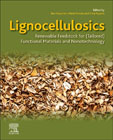
Lignocellulosics: Renewable Feedstock for (Tailored) Functional Materials and Nanotechnology
Filpponen, Ilari
Peresin, Maria Soledad
Nypelö, Tiina
Functional Lignocellulosics and Nanotechnology gives a comprehensive overview of recent advances in using lignocellulosic substrates in materials science and nanotechnology. The functionalization and processing of lignocellulosics are described via a number of examples covering films, gels, sensors, pharmaceutics, and energy storage. In addition to the research related to functional cellulose nanomaterials there has been an increased interest in research on lignin and lignocellulosics. Lignin is associated with cellulose in plants via biosynthesis. It is commonly extracted from the cellulose material to gain lignin-free raw material of high cellulose content. However, lignin as a valuable material itself has gained a lot of attention the last few years. Lignin research has shifted from extraction and fundamental characterization to preparation of exciting materials such as nanoparticles. The lignin researchers actively develop smart and stimuli-responsive lignin materials. Functional Lignocellulosics and Nanotechnology explains how utilizing biomaterials as a raw material allows ambitious reconstruction of smart materials that are green and multifunctional. Provides a detailed description of functional lignocellulosic materials and their propertiesBrings together research advances in the areas of chemistry, chemical engineering, physics and materials scienceConcentrates on the fundamental properties of lignocelluloseIncludes a unique coverage of lignin research INDICE: 1. Lignocellulosics and their use in functional materials and nanotechnology 2. Self-assembly of lignocellulosics 3. Surface modification of nanocellulosics and functionalities 4. Relevant characterization techniques 5. Lignocellulosic nanoparticles 6. Bio-based films as templates for functionalities 7. Aero- and Hydrogels 8. Templates for nanoengineered structures 9. Hybrid materials 10. Luminescent lignocellulosics 11. Conductive lignocellulosics 12. Bio-engineering 13. Applications in the medical field 14. Lignocellulosics in the area of energy storage 15. Lignocellulosics in different forms: broadening the scope of applications 16. Safety issues
- ISBN: 978-0-12-804077-5
- Editorial: Elsevier
- Encuadernacion: Cartoné
- Páginas: 510
- Fecha Publicación: 01/05/2017
- Nº Volúmenes: 1
- Idioma: Inglés
